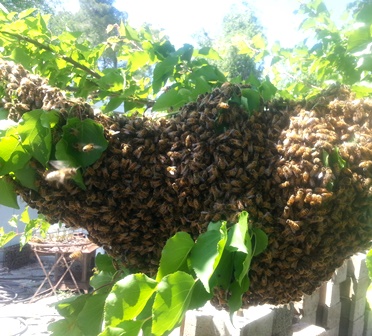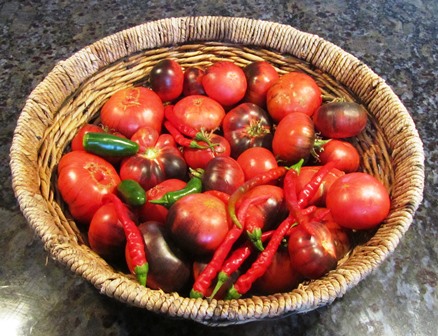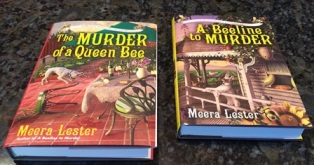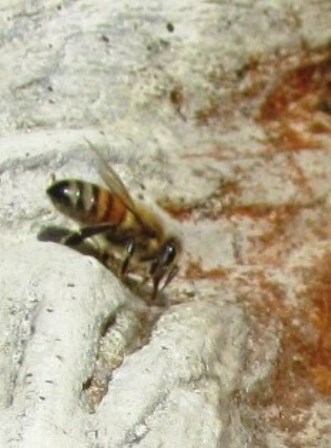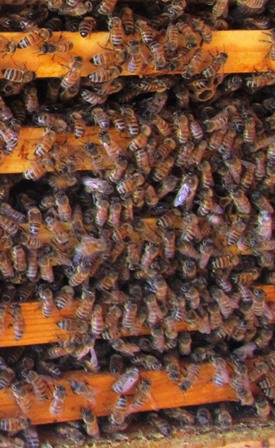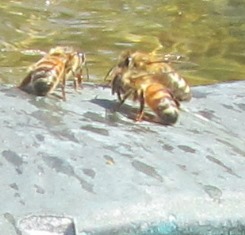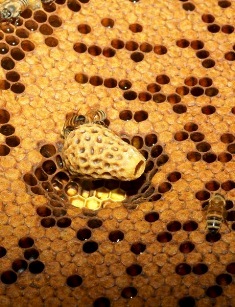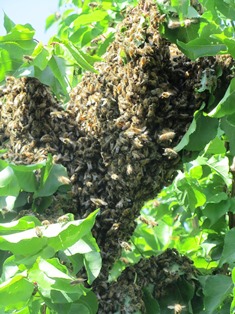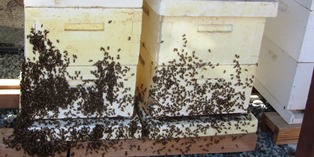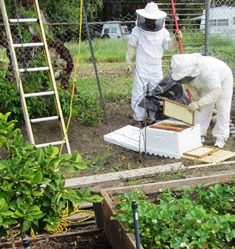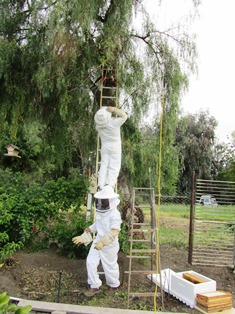Lemon Oil for Luring Honeybee Swarms
Call it my sixth sense at work, but after my bees acted aggressive (which they usually are not) as I cleaned the water fountain, I prepared the swarm catcher and put it in the apricot tree nearest my office window. Mid-morning on Wednesday, I got my first swarm of 2016.
Lemon oil is often the ingredient that lures the honeybees to a swarm catcher. I mix the lemon oil mixed with water and spray the swarm catcher with a pump sprayer. It usually works better to capture the bees in the swarm catcher than having them coalesce en masse on an inconvenient limb in a tree, say, fourteen feet up.
You can use lemon oil as a salve or in the oil form–apply the salve onto the swarm catcher around the opening for the bees or use the oil in a small plastic vial that gets inserted into a swarm catcher orifice.
Bear in mind that not all lemon oils are equal. Some are more “lemony scented” than others. Lemon oil is cold pressed from the peel and contains 3 to 10 percent citral (considered the most powerful of components that contribute to the lemon scent). Lemon myrtle contains 95 percent citral and, if it’s the scent you want, lemon myrtle is superior to all others.
So, when I realized my bees were swarming, I suited up and prepared a hive box with ten frames, eight with wax from previous honey harvests (where I left the wax intact) and two that I had in the kitchen where I was draining honey from them. It would provide an immediate source of food for the bees in their new home.
Today, I visited my favorite shop for all things honeybees and stocked up on a couple more hive boxes, just in case of another swarm, although the bees are quiet and non-aggressive again.
Planting the Spring Garden
Winter brought us lots of rain and now the ground has warmed up and is ready to receive the heirloom seedlings of our favorite vegetables and herbs.
Tomatoes won’t set fruit until the nighttime temps hover around 55 degrees Fahrenheit, but I tucked in several seedlings of heirloom varieties (Bradley, Cherokee Purple, and Red Beefsteak). Victory Seeds offers a nice selection of open-pollinated, non GMO, rare heirloom seeds for a variety of tomatoes. See, http://www.victoryseeds.com/tomato.html
While I was digging, my neighbor’s bees decided to swarm. So I stopped gardening to check on my own bees. They’ve been humming like a truck engine, and there has been a lot of bee traffic. Concerned that they might swarm, I set aside my shovel and got out the swarm catcher, the lemon oil, and the hand pump sprayer. I positioned the swarm catcher in a tree across the yard, sprayed the tree with lemon oil, and went back to gardening.
I’ve readied a patch of ground for the sweet corn, squash, peppers, and beans. Also, in a large-size planter pot, I’ve tucked in flat Italian parsley, Italian oregano, dill, chives, and sweet basil. The patio pot will remain near the kitchen slider in full sun so I have culinary herbs at the ready when I need them.
The early sweet peas are taking off now and the garlic and onions I put in the garden last fall are about a foot high. The vegetables and herbs I plant now will provide me with plenty of nutritious offerings right up until late fall–one of the many reasons to plant a garden in spring.
Enjoy this blog? Check out my Henny Penny Farmette novels, available online and in traditional bookstores everywhere.
Swarming Season 2016 Has Started
My beekeeper neighbor was working in his backyard this morning as I typed away on my novel. My office overlooks the garden and the fence between our properties.
Then . . . I heard the familiar clanging of a spoon against a pan. I leaped from my desk chair and ran to the kitchen. There, I grabbed a pot lid and wooden spoon and joined the banging at the fence between our properties.
I could see the brown cloud of honeybees in the air swarming near his apricot tree. We banged away for a while. It’s a bee-disorienting action that compels them to alight in a nearby tree or bush. “Have they landed yet,” I yelled. He replied that they had.
Thus begins the 2016 swarming season for the environs of the Henny Penny Farmette.
The Bees Won’t Wait
With so many flowers in bloom now, it’s time to add supers to the hives.
I can hear the buzzing from my patio, about twenty to thirty feet from the hives. My bees want to make honey, raise babies, and swarm . . . I know it.
My neighbor and I are opening hives tomorrow, but I worked out in the apiary today getting extensions (known as supers) ready. These have shorter frames and the bees use them to build wax cells and store honey.
I’ve got two active hives and extras. And I have several supers, complete with the shorter frames ready to go.
There are about ten frames I can use in a super that are being housed in the outdoor freezer. It’s where I put frames to kill anything that could live over on them that I don’t want in a hive, like a wax moth. The cold kills.
I also cleaned the bee glue off another hive box with larger frames in the event the bees decide to swarm sooner rather than later. The bees won’t wait. They’ll need a new house ready when they swarm or they’ll fly away and find one elsewhere.
Letting Gardens Dry Up Is Hard On the Honeybees
My neighbor, a world-class beekeeper whose honey sells to many specialty markets and also Whole Foods, told me today honeybees in backyard hives in our East Bay communities are hungry. He has put out two five-gallon cans of sugar water to feed his bees.
Interestingly, I’ve noted bees at my hummingbird feeders also usurping the sugar water meant for the hummingbirds.
The honeybees do not make honey from sugar water. They just consume it to have energy to forage for pollen and to cool the hives on hot days. The drought means people are watering less; flower gardens and local landscape are dry, and in places the clay soil is cracking open. Bad news for bees.
Weatherwise, it’s been triple-digit hot and then cold and cloudy. I guess the bees will adapt but old timers say, “A swarm in July means bees go bye-bye.” This isn’t the right time for swarming.
My hived bees are loud and energetic. The bees faked me out with a small swarm about ten days ago and then returned to the hive; and now they are eating sugar water for energy to gather what pollen they can find to make honey. The honey will see the hungry hive through until the star thistle and the fall eucalyptus blooms. I’m torn between letting my bee-loving flowers dry up to conserve water, but I don’t want to lose my bees.
A False Swarm . . . Sort Of
When I heard my neighbors banging on a pan with a wooden spoon, I sprang into action. It is what we do when a honeybee hive swarms.
As it turned out, my bees had swooped from the hive with their queen into the front yard, past the plum tree and were circling above the blood orange. My neighbors, who were in their courtyard, saw it and began the banging to confuse the bees so they would alight close to their home.
I ran out and, with direction from my beekeeper neighbor, placed the hive near the orange tree. I’d already placed eight frames with wax and my neighbor brought over two with honey on the comb. All seemed to go as planned. We shook the tree and the bees dropped into the prepared hive.
My neighbor went home, and I went back to my computer and the novel I’m writing. Thirty minutes later, the bees were swarming again. I ran out and banged on the pan. They settled down. All seemed well, except for ants that had been in the orange tree and now were in the hive box.
Around nine o’clock at night, I sprayed the outside of the hive with Windex and wiped it with paper towels. I repeated the procedure around the perimeter of the box, replaced the lid, and carried the hive box back to the apiary believing all would be well. It wasn’t.
This morning, I ran out and suited up in my beekeeper’s outfit and gloves, opened the new hive box, and looked in. To my dismay, all the bees were gone.
My neighbor later told me over coffee that the bees had likely returned to their old hive as small swarms sometimes do. So . . . I suppose I may be repeating this whole scenario at some point in the days ahead. My neighbor reminded me that the weather has been strange, and the weather affects the bees’ behavior.
Sixty Pounds of Honey, Death of Some Drones, and a New Swarm
I opened my hives this past Sunday with the help of my world-class beekeeper neighbor. We checked on the the condition of eggs, the number of new queens, the growth of baby bees, the presence of mites (none detected), and the amount of honey (lots).
The male bees (the drones) over the last weeks have been engaged in some crazy flight patterns in front of the hive as the mating of the queen takes place. The old queen has done her egg laying and the hives have lots of babies with nurse maids and other worker bees. From the hives comes the clearly audible sound of humming and the fragrant scent of honey.

The drone (male bees) are vital for mating with the queen; after that, they are unnecessary and are eliminated
The drones are not now needed and the workers in the colony are doing away with them. I found a stack of drones at the front door of the hive this morning. Strange sight to see, indeed. But no more so than the many queen houses (formed from honeycomb by the worker bees). These houses are where the new queens are nourished; each contains royal jelly.
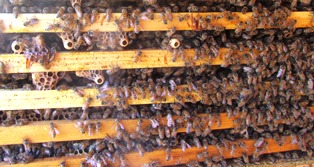
The tubular circles are the houses where the baby queens will be cared for by the workers. The houses contain royal jelly for the feeding of the new queens
My neighbor told me to wait three more weeks to take honey, but since I didn’t take any honey during the fall/winter and there were huge stores of it in my hives and coupled with the fact that there’s a plethora of flowers now to provide pollen for the bees, we decided it would be okay to remove some frames. So, I took six frames (weighing roughly ten pounds each) from the hives.
The honey I harvested has a pale lemony color–significant for the wildflowers and almond and fruit tree blossoms from which the bees collected the pollen to make that honey. In the fall, the honey is darker and earthier tasting, thanks to pollen from the star thistle and eucalyptus blooms.
When we had finished with my hives and walked back to my neighbor’s house, we spotted a swarm overhead. We grabbed the pots and wooden spoons and started banging. The bees took refuge in the tall pepper tree and that’s where my neighbor rescued them. In all, it was quite a spectacular Sunday!
20 Interesting Facts about Honeybees
If your fruit trees, berries, and flowers are flourishing, you can be assured that bees have been busy in your garden. If you are a gardener who lives near a beekeeper, consider yourself really fortunate. Eighty percent of pollination is attributed to bees. Without these industrious little insects, Earth’s plant diversity would be in jeopardy. Here are some other interesting facts about honeybees (apis mellifera).
WORKER HONEYBEES
1. The worker honeybees are sterile females. The workers keep the hive clean, serve as nursemaids to the babies, forage for food, scout for new locations, stand guard at the hive entrance, and care for the queen.
2. The lifespan of a worker bee is 6 to 8 weeks; the queen’s lifespan can stretch to 3 years.
3. In her short lifetime, an average worker bee will produce about 1 1/2 teaspoons of honey.
4. A honeybee will travel about six miles from its hive to forage on nectar- or pollen-rich plants.
5. Honeybees never sleep.
6. During one collection flight, a honeybee will visit between 50 and 100 flowers.
THE QUEEN
7. A honeybee queen is made or created (as opposed to being born). Worker bees secrete royal jelly through the glands in their heads (hypopharynx and mandibular) to feed the larvae. Rich in vitamins and nutrients, the royal jelly may also contain a single protein known as royalactin and scientists believe this ingredient ensures the larva becomes a queen.
8. Newly emerged queens will fight to the death, leaving only one to rule the hive. The honeybee queen lays around 2,000 eggs. These become fully developed in 21 days.
9. The queen doesn’t leave the hive. Her job is to mate with the drones, produce eggs, and serve as matriarch of the colony.
THE DRONES
10. Drones are bigger than the worker bees but smaller than the queen and have rear-ends that are more blunted than round.
11. The drone’s sole purpose is to mate with the queen, which he does in the air. Drones die during mating.
12. Drones do not have stingers unlike the worker bees who have stingers with bee venom.
13. Drones are kicked out of the colony in the autumn when mating season in over because the honey reserves are needed to support the colony’s queen and workers through the winter. The drones are expendable since they don’t forage for food, make honeycomb or honey, care for the babies, clean the hive, or otherwise contribute to the colony.
THE COLONY
14. Honeybees communicate with each other through chemical signals. When there is a predator present, the worker bees release a pherome that communicates to her hive mates the need to attack.
15. The primary swarm (with the old queen) happens in spring and is a colony in transition. Swarming is the method by which the bees leave the hive en masse to establish a new colony. Swarming usually occurs during a two-week period in spring on warm days.
16. A swarm can include 10,000 bees but they are not in attack mode; they are preparing to move to a new home with their queen and are carrying the honey they need for the trip in their stomachs.
17. Honeybee colonies have been around for millions of years. There are fossils of honeybees in European deposits dating back 23 to 56 million years ago.
HONEY
18. Honeybees are the only insects that produce a product that humans eat. Honey is highly nutritious and has many health benefits.
19. Honey never goes bad; honey was found in King Tut’s tomb.
20. It takes more than 500 honeybees collecting pollen from 2 million flowers to make 1 pound of honey.
Swarming Season Has Arrived!
What’s not to love about spring? It’s only the middle of April and already we’ve seen several honeybee swarms. Swarming is how the bees reproduce their colonies and most often occurs during the warm days of early spring.
My neighbor, whom I’ve often called a world-class beekeeper (his father kept honeybees in Lebanon and taught him well) permitted me to keep his bee swarm that alighted in my apricot tree. He also generously donated a super (hive box) with some frames that already had wax, honey, and capped brood–all from his own apiary.
The newly housed honeybee workers delight in foraging on the various types of lavender (Spanish, English, and French perfume) that I’ve planted around the farmette. The colony will build up the wax and make honey while the nursemaid bees will care for the brood.
My husband, the architect-turned-farmer/beekeeper, has constructed a unique bee house for the hives. It will keep the bee boxes dry during winter rains and out of reach of marauding animals (skunks and raccoons). Resting on a platform that Carlos built on top of a newly installed brick floor, the hives are not within easy reach of the ever present ant population.
Alas, the bees weren’t about to wait until Carlos finished building their house. The swarm happened when the bees were ready to take flight (some 60 percent of the workers with their old queen) flew into our apricot tree.
If you see a swarm, call your local beekeeping association (or any store that carries local honey) for the name of a beekeeper. Avoid the temptation of spraying water or anything else on the swarm. Permit the beekeeper to safely remove the swarm.
For a beekeeper, rescuing a swarm is a truly exhilarating experience. Often a swarm consists of thousands to tens of thousands of honeybees. Beekeepers routinely rescue swarms from where bees have temporarily clustered while the bee scouts seek a permanent home. The beekeeper can shake them into a prepared hive box, leaving the box at the hive cluster site until all the bees are inside. At that point, the beekeeper takes the new hive to his apiary.
The beleaguered honeybees (whose populations have been decimated by the Varroa mite, weakened immune systems, and Colony Collapse Disorder) need help to survive and increase their populations. We need them, too! Without their pollination of fruit, nut, and other crops, our own food sources diminish.
Saving the honeybees is a good practice whenever possible because doing so ensures abundance and diversity in the plants we eat. Whenever I see a cluster of bees in a tree I feel joyful and celebratory. Is it any wonder that swarming season is my favorite time of the year?
A Swarm in July Isn’t Worth a Fly
There’s an old proverb about bees that goes: A swarm in May is worth a load of hay, a swarm in June is worth a silver spoon, but a swarm in July isn’t worth a fly. You might wonder why.
Well, I asked my beekeeper neighbor that question this morning as we suited up to feed the bees and take some frames of honey. The hives were thriving, bees were active, and the honey production copious. He harvested some, but also left some for the babies that the queen had produced.
There are spring flowers in May and new flowers in June, but by July many of the flowers that the bees love to forage on have flowered and gone to seed. If the queen lays lots of babies, where will the worker bees get enough pollen and nectar to support the entire hive, feed the queen, and supply the babies?
During fall in Northern California, the bees can forage on the eucalyptus blossoms, but then, they must survive through winter. I see bees on my December roses, but there aren’t a lot of flowers blooming in December that have high pollen and nectar loved by the bees.
Swarming in May and June is a sight to behold. Swarming is way the bees of deal with hive/nest overcrowding. It is how they increase their populations. See, http://entomology.unl.edu/beekpg/beeswarm.shtml.
A savvy beekeeper is ready to capture swarms as soon as the weather warms up in late spring. The bees won’t wait, although it is possible for a seasoned beekeeper to anticipate a swarm and take action to avert it. But it doesn’t always work.
An apiarist must manage his or her colony of hives and anticipate the needs and activities of the bees for the coming season–at this time of year, that means during fall and winter. Without a lot of food growing to support a new hive of bees from a captured swarm, a swarm in July isn’t worth a fly.
 Facebook
Facebook Goodreads
Goodreads LinkedIn
LinkedIn Meera Lester
Meera Lester Twitter
Twitter






